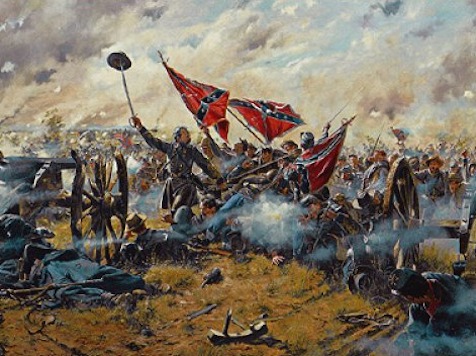Charles Spinks stepped out of the Gettysburg woods into the intense heat of July 3, 1863. His eyes blinked in the bright sunlight as he watched 12,500 comrades form up in the tall grass in front of the woods. It was strangely quiet now that the artillery bombardment had ceased. About 3/4 of a mile in front of them, the Union soldiers waited.
Although 45 years old at the time, Charles had joined the 8th Virginia regiment when it was formed in 1861. Company K, his unit, had been recruited from his home in Fauquier County. He left behind a wife, three children, and his job as a farmhand to support “the cause”.
The 8th Virginia formed on the right flank of General Garnett’s brigade in the front line. Garnett himself was mounted on his horse. It was a suicidal act that would draw the fire of every Yankee sharpshooter, but Garnett had recently been accused of cowardice by no less a figure than Stonewall Jackson. He was making a point.
General George Pickett rode to the front of the division, made a short speech, and pointed toward the Union lines. The assembled men moved forward. If the men were to run, they would arrive individually and be slain individually. So they walked briskly in formation. The Union artillery resumed its bombardment on their now unsheltered ranks. As the artillery blew gaps in their ranks, the sergeants yelled “Close it up.”
They were moving downhill on a gentle grade through a slight valley between Seminary Ridge, where they had started, and Cemetery Ridge, where the Union troops awaited. But the Union had posted a skirmish line in front of the main position and musket fire began taking its toll on the formation. At the bottom of the valley was a road and a fence. Because the rebels had to stop and remove the fence, or slow and climb over it, the lines compressed there, and it was easy pickings for the Yankees. The Union army had pre-aimed its cannon at the fence line, and the cannon were shooting “canister”—fragments of broken metal, acting like giant shotguns, mowing down whole groups of men.
Finally, the order came for “double-time” and the men began to run, but as they approached the low wall providing shelter for the Union troops, the fire became too intense, and they laid down to take whatever shelter they could. General Armistead raised his black hat on the end of his sword, pointed toward the wall, screamed, “Virginians! With me!”, and moved forward. They followed and reached the wall. For a moment, the blue-clad soldiers fell back, but then returned with awe-full intent. Bearers of the 8th Virginia’s regimental flag were successively shot until there was no one to pick the flag up again.
Thirty minutes after the attack began, the survivors had fallen back to their starting point. The 8th Virginia had a nominal strength of 750 men, but losses during previous battles had reduced their strength to only 243. During Pickett’s charge, 34 were killed, 33 wounded, and 101 were captured—a total of 168 casualties, a 70% casualty rate. They earned their nickname, the “Bloody Eighth”.
Confederate records were sparse to begin with and many are lost. There is no way to know whether Charles Spinks was actually at the battle. A daughter, Martha, was born on 7 Sep 1865, suggesting that he was not with the Army of Northern Virginia for the last few months of the war. Perhaps he was wounded and sent home. Perhaps he was captured and then paroled. Perhaps he decided on his own that the war was lost and simply went home, as many did.
The only facts we have are his application for a pension from the State of Virginia in 1906, when he was 90 years old. That application provides only the sparest of facts—those of his enlistment—and a claim that his disability was caused by wounds suffered during the war.
Charles Spinks was the second great-grandfather of the Moore brothers.
—Many of the details of the battle are taken from Jeff Shaara, The Killer Angels, 1974.
—Casualty figures are taken from Eugene Scheel, "30 Gruesome Minutes for the 'Bloody Eighth'," The Washington Post, 2 July 2000. HTML edition, archived. https://www.washingtonpost.com/archive/local/2000/07/02/30-gruesome-minutes-for-bloody-eighth/466087b9-9df5-40ed-9fec-54eec4d67d70/ : 2015.
